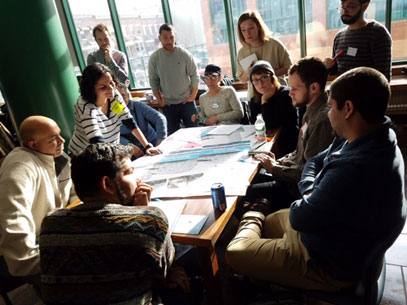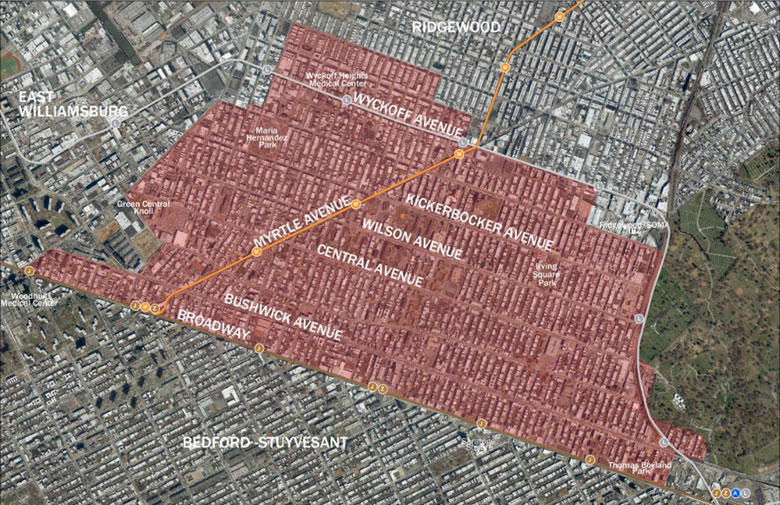
 Department of City Planning311
Department of City Planning311 Search all NYC.gov websites
Search all NYC.gov websites
Press Releases
For Immediate Release
April 24, 2019
Contacts:
Rachaele Raynoff, Joe Marvilli – press@planning.nyc.gov (212) 720-3471
Department of City Planning Announces Release of Update to Bushwick Neighborhood Plan
Developed using core principles outlined by the community, the plan aims to create and preserve affordable housing, spur job growth and address longstanding community needs in this growing neighborhood

NEW YORK - Department of City Planning (DCP) Director Marisa Lago today released the Bushwick Neighborhood Plan Update. The action plan is based on four years of community input, and includes a host of new programs and investments to support neighborhood residents. In 2014, DCP was asked to support a community-led planning process to outline stakeholders’ hopes and priorities for the area. Council Members Antonio Reynoso and Rafael Espinal, along with Community Board 4, initiated the planning process, the Bushwick Community Plan (BCP), in response to concerns regarding out-of-character development and resident displacement, and a lack of affordable housing. The Bushwick Neighborhood Plan Update, released today, creates a roadmap to meet the community’s goals.
“Bushwick residents are justifiably proud of their dynamic community, one that is home to thousands of diverse families. As this transit-rich neighborhood continues to thrive, we are determined to preserve and create affordable housing, protect tenants, help grow more good jobs, improve parks, schools and sidewalks. We look forward to continuing to work with this dedicated, vibrant and strong community,” DCP Director Lago said.
The City’s proposal is designed to meet multiple objectives outlined by the community to grow and preserve affordable housing and jobs, increase opportunities for small business, and address neighborhood needs for open space, safer streets and more. Since 2000, Bushwick’s population has risen by nearly 15 percent, which is greater than the city rate of increase, and it has put upward pressure on rents and the neighborhood in general. The neighborhood’s current zoning allows a diversity of building types but does not require the inclusion of affordable housing in new developments, which has resulted in a boom in market-rate housing construction.
“As this city continues to grow, we must ensure that all New Yorkers have the resources they need to call New York City home. Under the Mayor’s Housing New York plan, we’re committed to a community-driven approach to plan for the path ahead, that not only anchors our neighborhoods with affordable housing, but promotes economic prosperity as well,” said Acting HPD Commissioner Eric Enderlin. “I thank our colleagues at the Department of City Planning and local elected officials for taking this important step toward shaping a secure future for the diverse Bushwick community.”
The Bushwick Neighborhood Plan Update outlines strategies to:
- Create and preserve affordable housing;
- Protect tenants;
- Expand technical assistance to local businesses and connect residents with economic opportunity
- Develop land use and zoning actions to reinforce job-generating uses in industrial nodes;
- Enhance community health;
- Support local arts and culture;
- Improve pedestrian safety;
- Improve parks and open spaces
The Bushwick Neighborhood Plan covers roughly 300 city blocks generally bordered by Broadway to the south, Cypress Avenue to the north, Flushing Avenue to the west, and Trinity and the Evergreens Cemeteries and Broadway Junction to the east.

Since 2014, DCP has participated in more than 150 meetings with the community and its elected officials, provided analysis, and helped facilitate visioning sessions large and small. DCP convened key City agencies to identify additional neighborhood investment opportunities.
Ongoing neighborhood improvement strategies to help address local needs include:
- Opportunities to advance affordable housing on public land, including plans for new affordable family and supportive housing on Broadway and 154 senior apartments at NYCHA’s Bushwick II development.
- Transportation safety improvements to be implemented this year along Myrtle Avenue to improve conditions for pedestrians as well as the installation of new temporary Citi Bike stations, which could lead to a potential expansion of Citi Bike in Bushwick.
- A new $3 million half acre of open space, named Beaver Noll Park, at Bushwick Avenue and Beaver Street is expected to open later this year. In addition, NYC Parks is advancing more than $10 million in improvements to existing recreation areas that are either under construction or will begin construction by next year.
- Deployment of the Department of Small Business Services mobile outreach unit and its Chamber-On-the-Go team this spring to connect job seekers and small businesses with needed services.
- Expansion of the Shop Healthy Program to Bushwick to increase access to fresh, healthy food through technical assistance to food retailers by the Department of Health and Mental Hygiene. This program, already underway, complements the FRESH program that incentivizes neighborhood grocery stores.
- Boost support for local community-based organizations in developing strategies to improve access to arts and culture programming by the Department of Cultural Affairs.
- A plan by the Landmarks Preservation Commission to evaluate three areas flagged by the community that could lead to historic district designation.
Housing and Jobs:
Developed with core principles outlined by the community, the plan aims to create affordable housing and job opportunities on transit corridors while protecting the scale of the neighborhood. Accordingly, the plan details a land use framework with zoning changes that would:
- Protect the character of 70 percent of the study area through contextual zoning. Applied on side streets and lower scale corridors, contextual zoning would limit buildings heights and require that buildings line up with those next to them along the street, preserving the look and feel of the neighborhood fabric.
- Encourage multi-story developments with ground floor stores or community facilities on transit corridors, such as Broadway and Myrtle Avenue. This would facilitate job creation as well as promote new housing, including permanently affordable housing as required by Mandatory Inclusionary Housing.
- On other neighborhood corridors, including Knickerbocker, Central, and Wilson Avenues, mixed income housing and retail (where appropriate) would be fostered at medium density.
- In industrial areas, lower parking requirements, increase allowable floor area, and establish height limits to encourage construction of new job-generating industrial, commercial and community facility buildings that respond to surrounding neighborhood character.
The Bushwick Neighborhood Plan Update was presented by DCP at Community Board 4 on April 23rd. It reflects priorities that were identified during multiple planning meetings since 2014 and documented in the Bushwick Community Plan’s September 2018 report. DCP looks forward to continuing discussions on the future of Bushwick. Later this spring, a scoping meeting will be scheduled to take public comment that will inform the Draft Environmental Impact Statement for the Bushwick Neighborhood Plan, a prerequisite for public review.
For the latest on the Bushwick Neighborhood Plan or to contact the planning team, sign up for emails.


